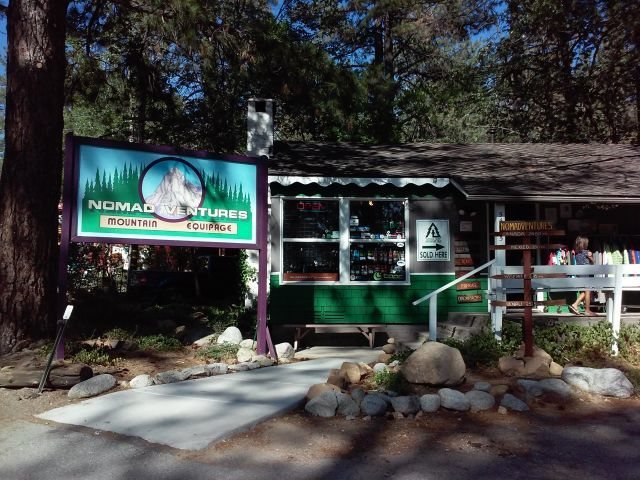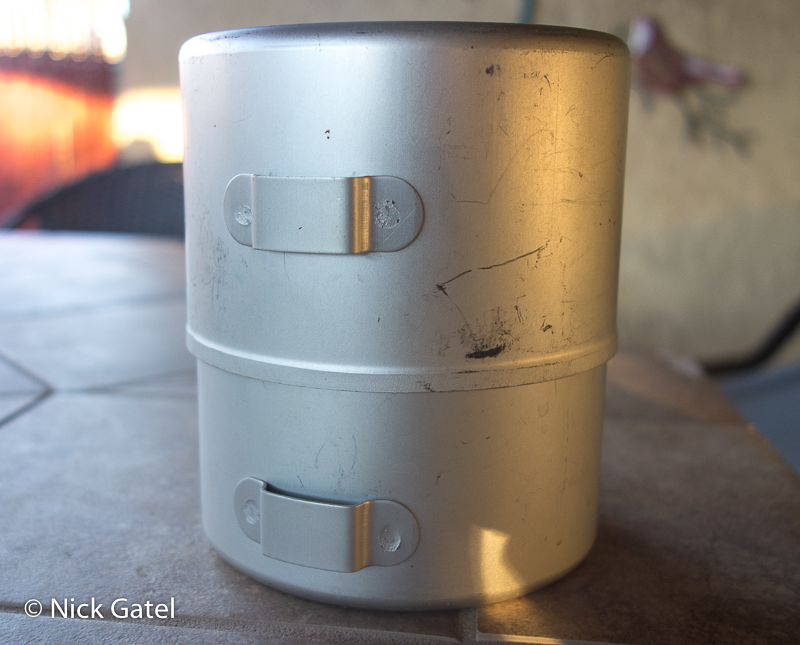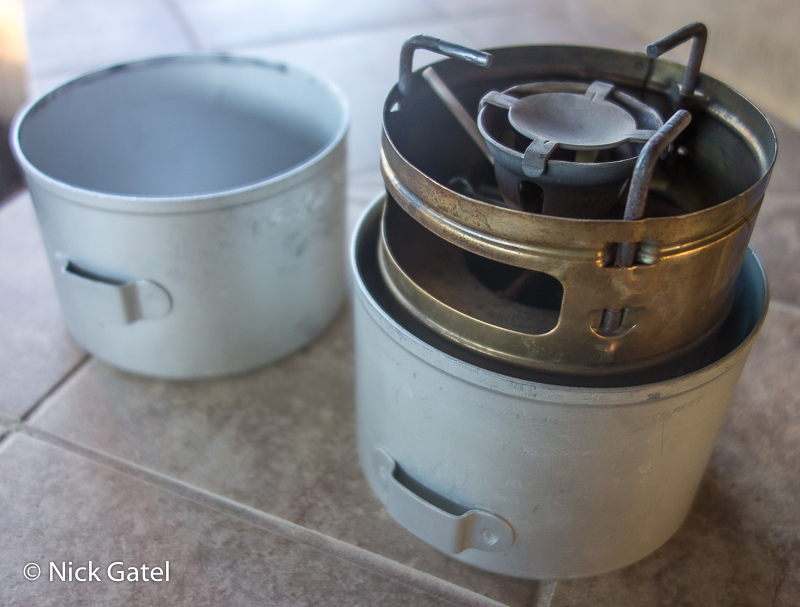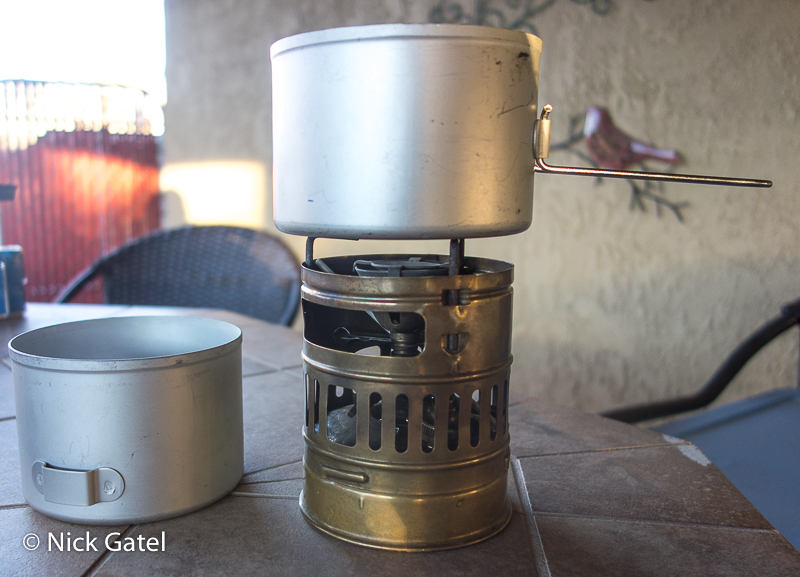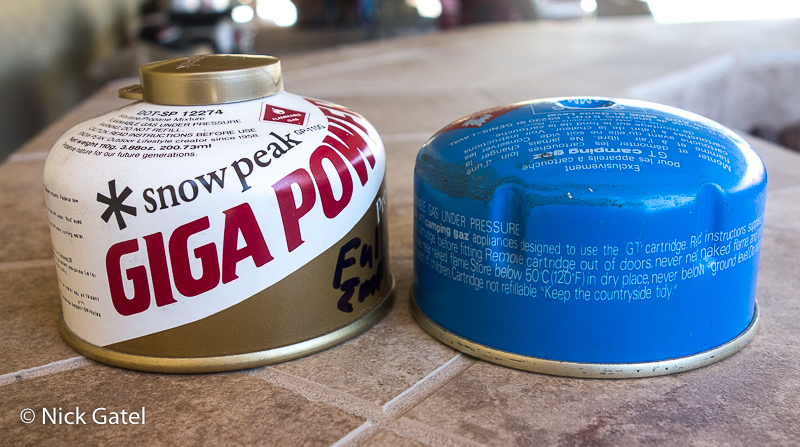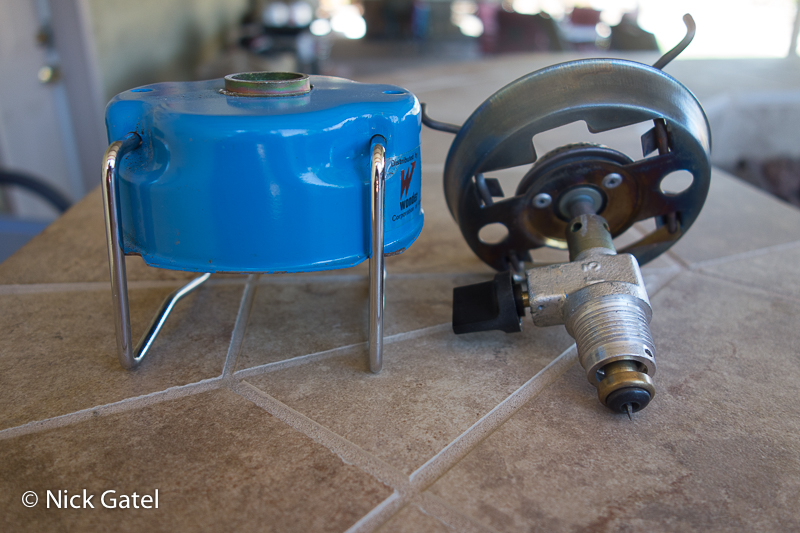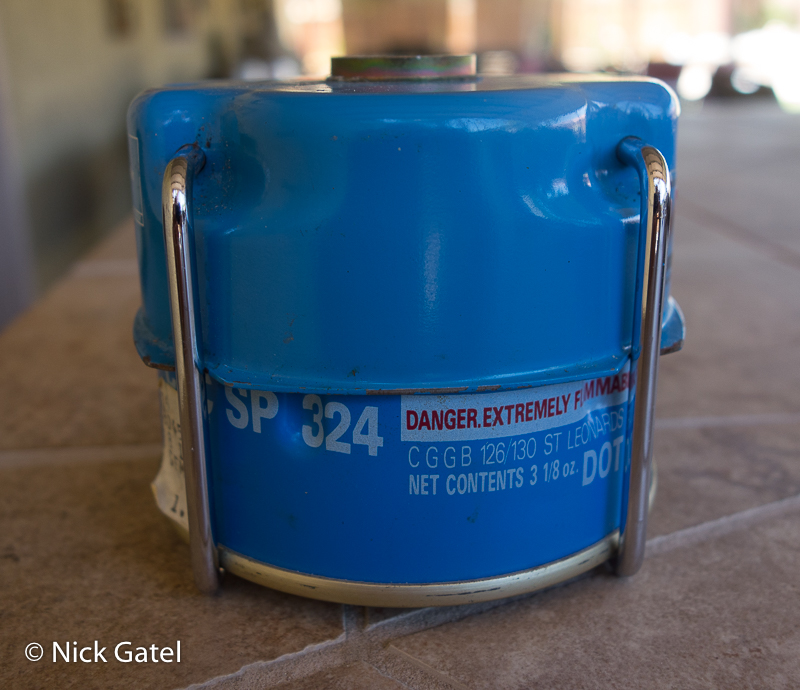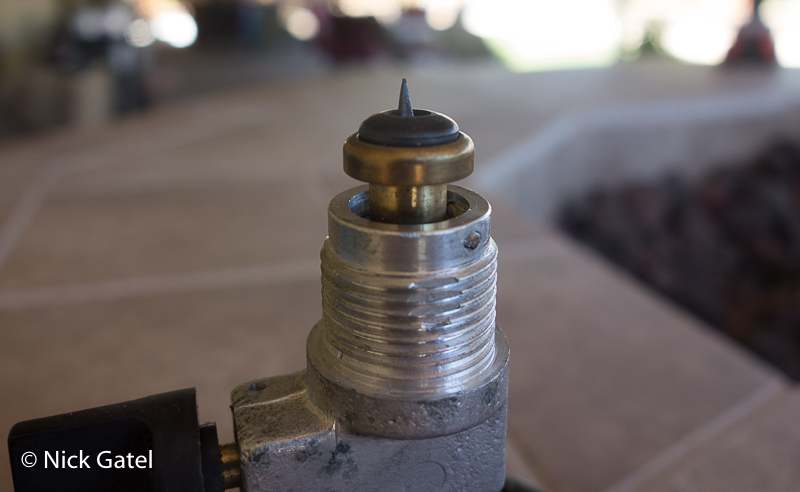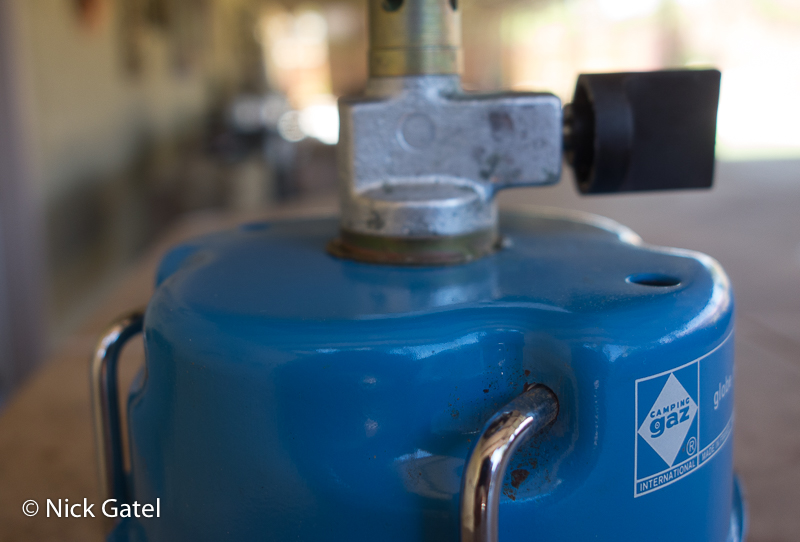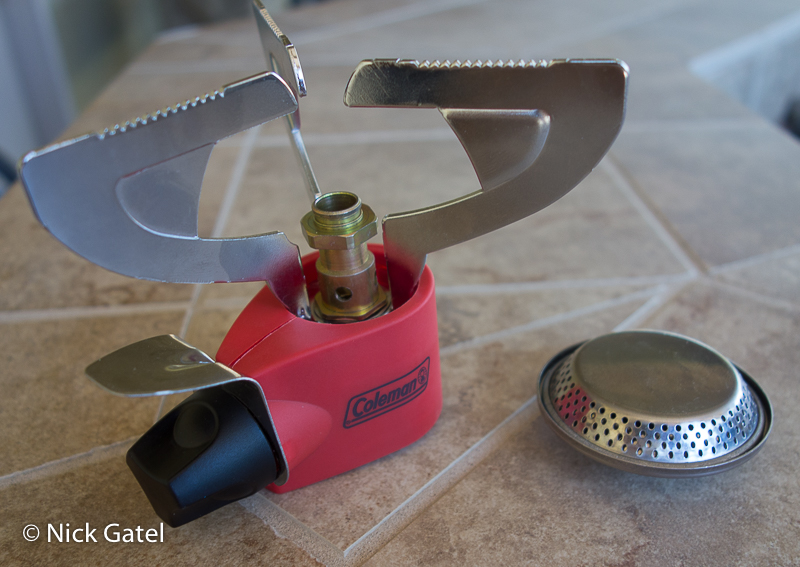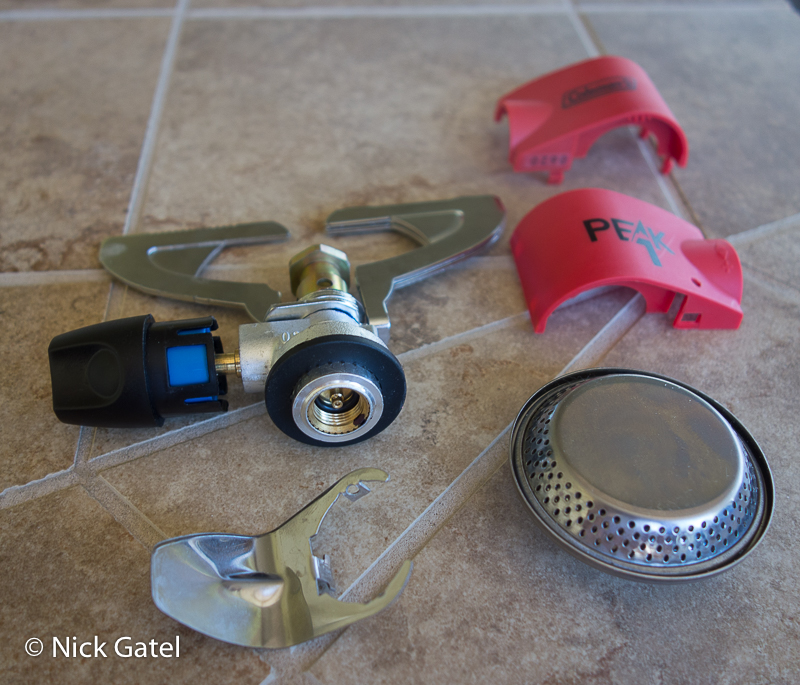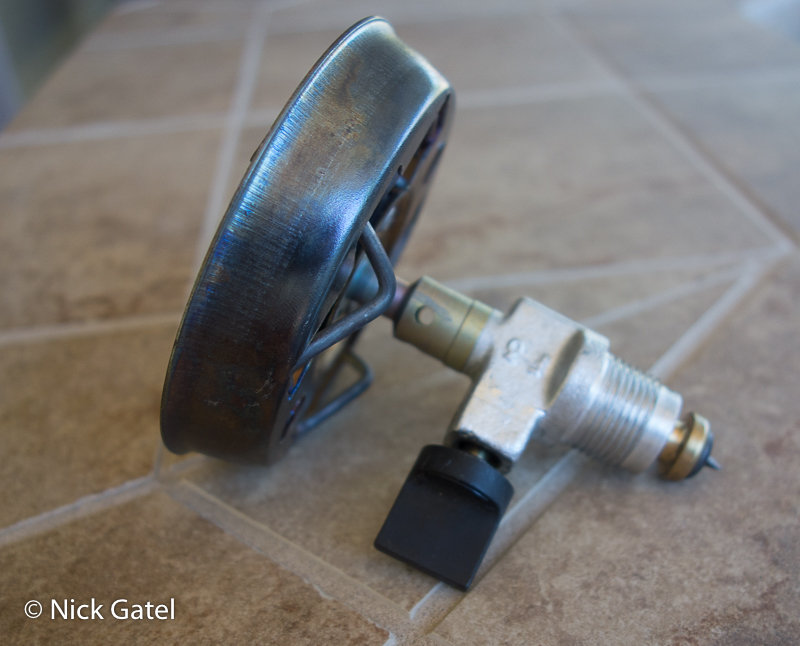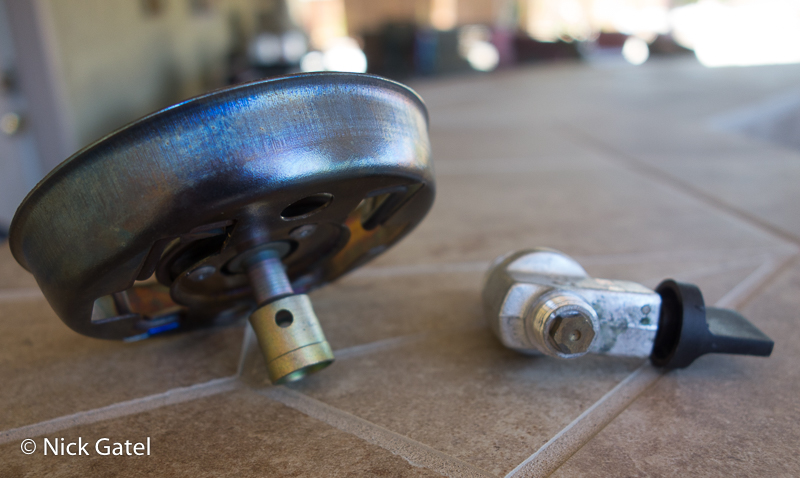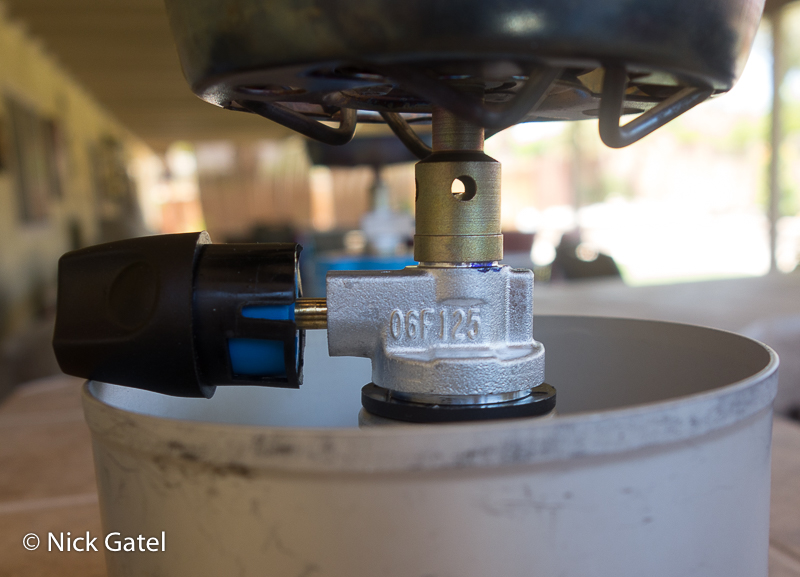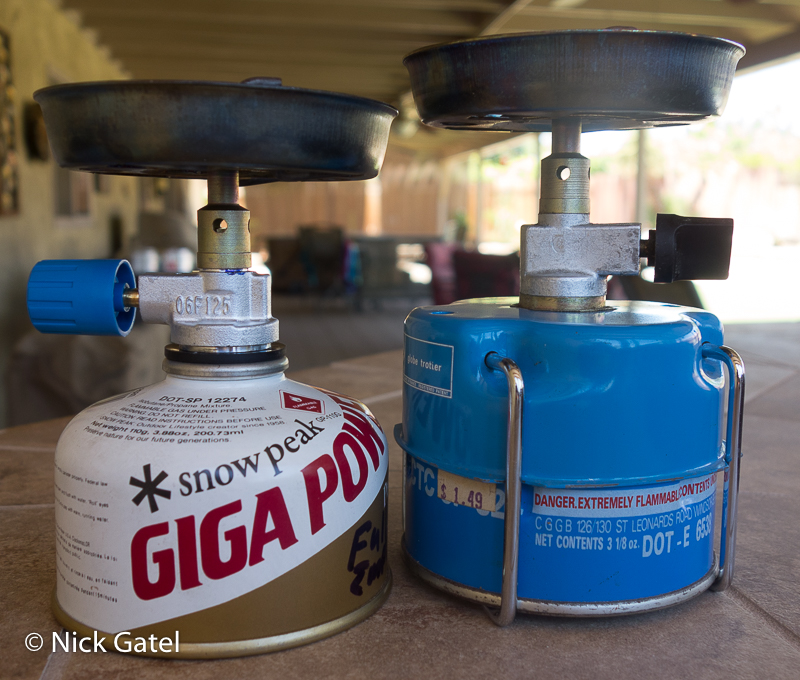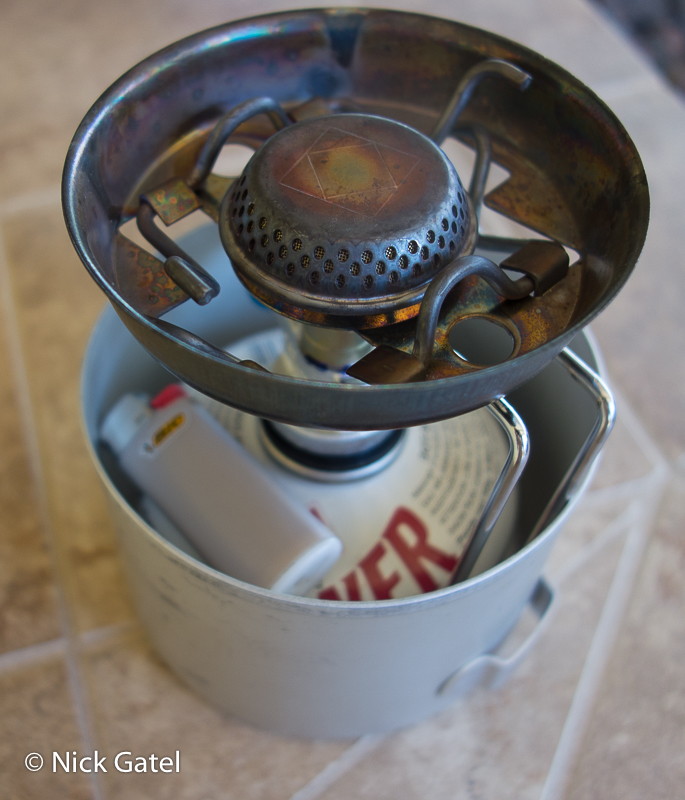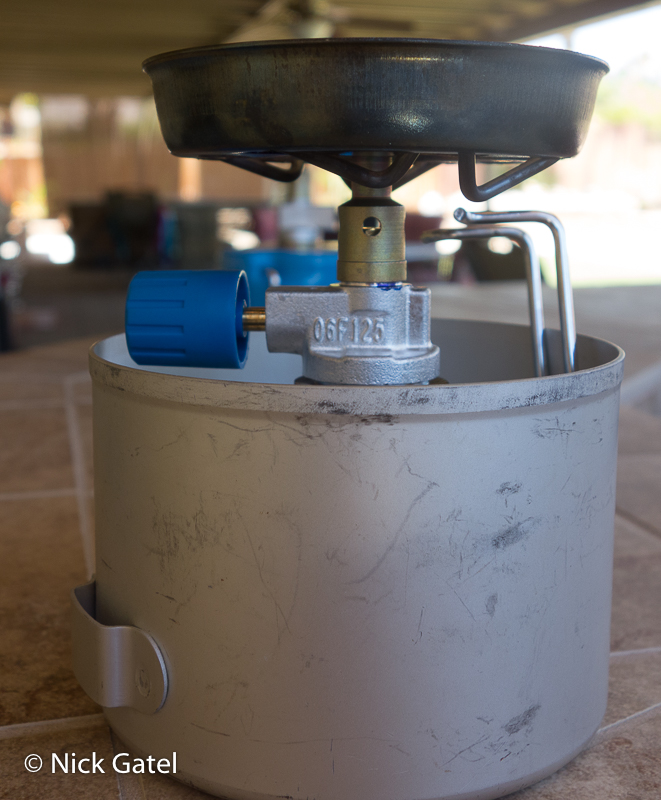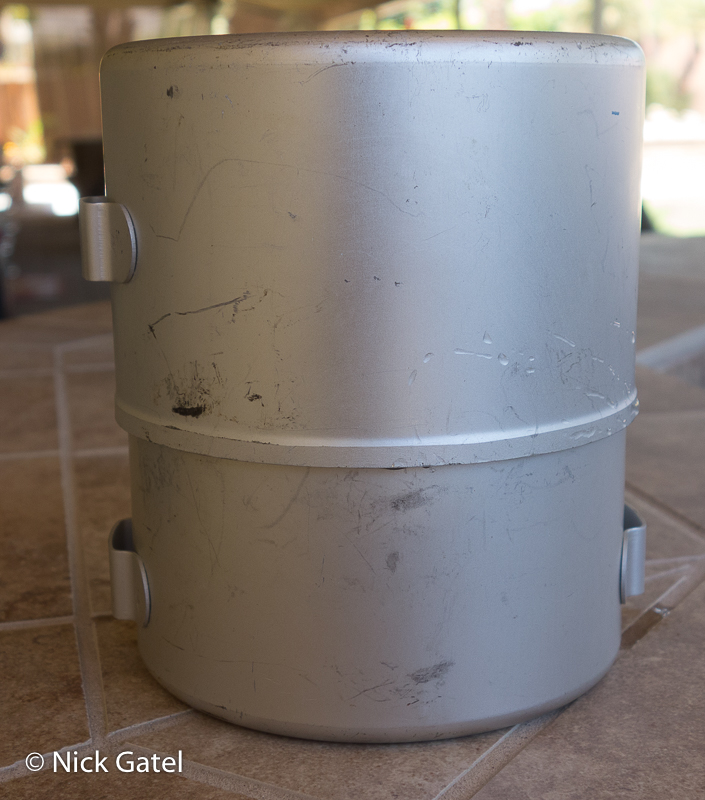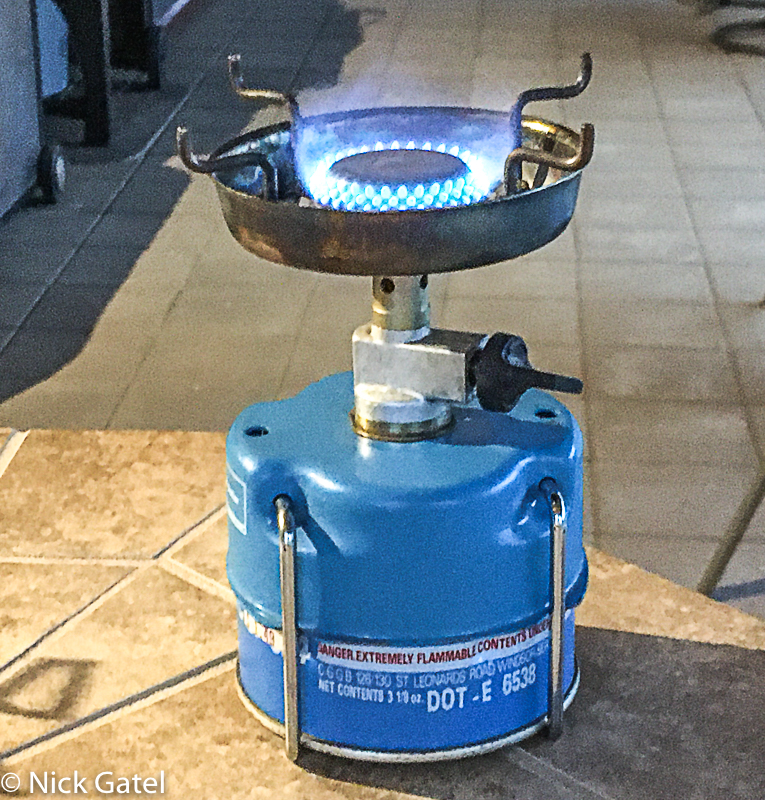
I haven’t reviewed this stove because it is no longer made. More importantly, if you have one or buy a used one, you can’t buy the canisters anymore either. However, for several reasons, this has always been my favorite canister stove. I liked it so much; I bought a second stove in case the stove was discontinued — which it was. What I didn’t anticipate was the fuel canisters would also become obsolete. Given all of this, I was able to re-work the stove and make it compatible with the common IsoPro canisters that are popular today. So, it is time to review the stove, because it can be updated, and actually made lighter. Even more exciting, at least for backpackers who are always trying to lighten the weight of their gear, the update to the stove reduces the stove weight from 10 ounces to 5 ounces: a weight reduction of 50%.
Why I Bought This Stove
Sometime in the early ‘80s I put together a long and strenuous loop in the San Jacinto Mountains. Starting in Palm Canyon, where the largest palm oasis in North America is located, I would hike 16 miles up the canyon. This is an elevation gain of 4,000 feet through mostly difficult desert landscape and no real trail for the second half. From the top of Palm Canyon, I would work my way north along some ancient trails until I connected to the Pacific Crest Trail (PCT) near Hwy 74. From here I would hike east on the PCT, then down to Cedar Spring. From Cedar Spring I would drop down to Garnet Ridge, then descend West Palm Canyon down into the main Palm Canyon where I started. A difficult trip, but hey, I was in my early ‘30s and an extremely strong hiker.
Equipment Failure — Optimus 731 ‘Mouse Trap’
The first night, after hiking 10 miles, my stove (an Optimus 731 “Mouse Trap”) broke. More precisely, I broke the needle that is inserted into a butane canister. This stove, which was probably designed by someone who doesn’t backpack often, was slick in theory, but not very practical. The biggest issue was it isn’t very stable. Now if you place it on a picnic table, which is a nice flat surface, it could be fairly stable. But it is supposed to be a backpacking stove and there aren’t picnic tables in the backcountry.


The stove used one of the early canister designs, which I think was first brought to market by Hank Roberts. The top of the canister had a self-sealing rubber grommet. The needle of a stove was pushed into this canister grommet to feed fuel. If the stove was removed, the grommet would shut close. Well, in theory it would close. Most of the time it did. What is interesting about this design is the stove had a tube connected to the grommet valve, which allowed it to feed liquid into the stove, not vapor. So it worked in colder weather, unlike the Globetrotter. With the 731, the stove needle was inserted into the canister, and the stove legs on the burner side (right legs in photo above) were snapped under the canister. The canisters for the stove have long been discontinued, so I don’t have one to demonstrate. If you look closely at the picture below, of some old Optimus brand canisters, you can see a diagram of the canister inserted into a 731 stove (between) the two “702” markings.
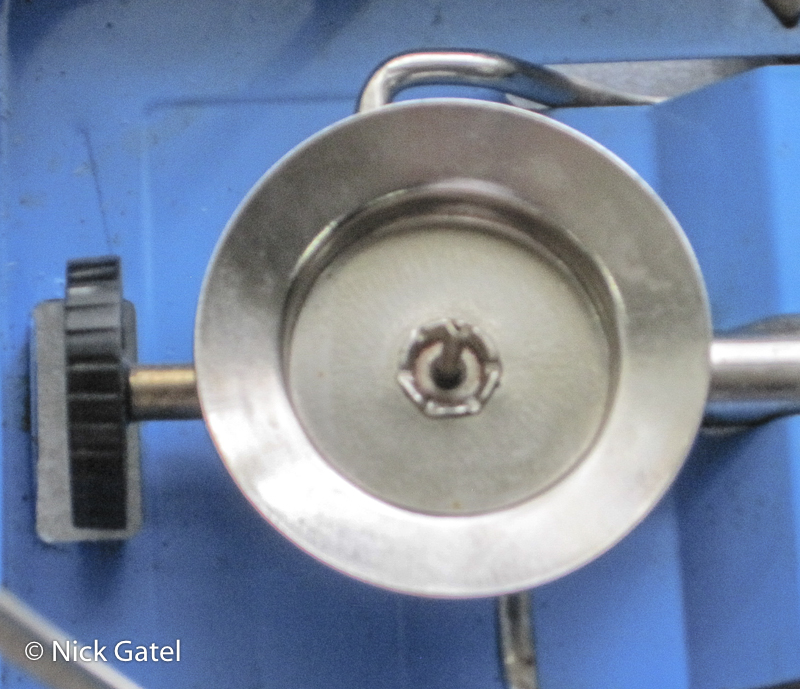
So on this trip, I broke that needle the first night. It must have been a common problem, because when I called the company, they immediately sent me a new one without asking me to return mine.
No Cell Phones
Back in those days, there were no cell phones, which was a great thing. I decided to climb out of Palm Canyon, cross over the San Jacinto Mountains into the little town of Idyllwild, and see if I could buy a new stove. A big change of plans without calling my wife or letting someone know where I was or might be. But, hey, that’s how my generation operated in those days. We didn’t live in constant fear of what “might” happen. It took me a day and a half to get to Idyllwild.
I stopped into a little mountaineering store, Nomad Ventures (which is still in operation) and bought the Globetrotter.
Why The Globetrotter was Such a Great Little Stove
After using the stove for the rest of this trip, I was impressed. Gaz had released it in the late ‘70s and it was:
- Light for the time
- Had a built-in windscreen
- Fit into the included pot set, even with a canister attached
- Came with two 20 ounce aluminum pots, a pot handle, and a nylon strap to secure it as a compact and complete cook set
I still have both of the original instruction pamphlets. You can view the instructions here.
Windscreen
Canister stoves are easily disrupted by wind and even gentle breezes, as discussed in this thread reviewing the MSR WindPro II.

The Snow Peak stove does okay with the heavy optional windscreen. However, the Gaz Globe Trotter does better. While the wind is blowing the Snow Peak’s flame around, the Globe Trotter isn’t affected (see below).
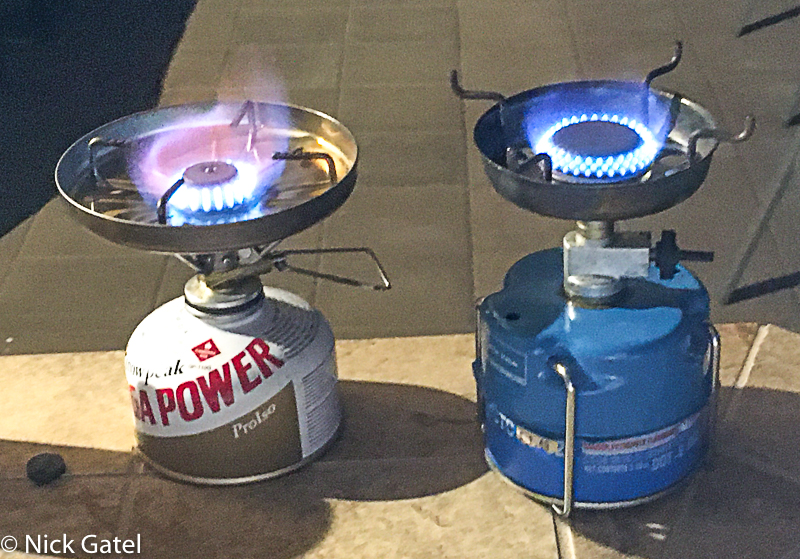
There was a slight breeze when I took the picture. Notice how the Globetrotter’s flame is not affected as much as the GigaPower with the optional windscreen.
Pot Supports
The pot supports are turned up at the ends, which really keeps the pot in place and centered. They are built to fit the included pots perfectly. What a nice touch! 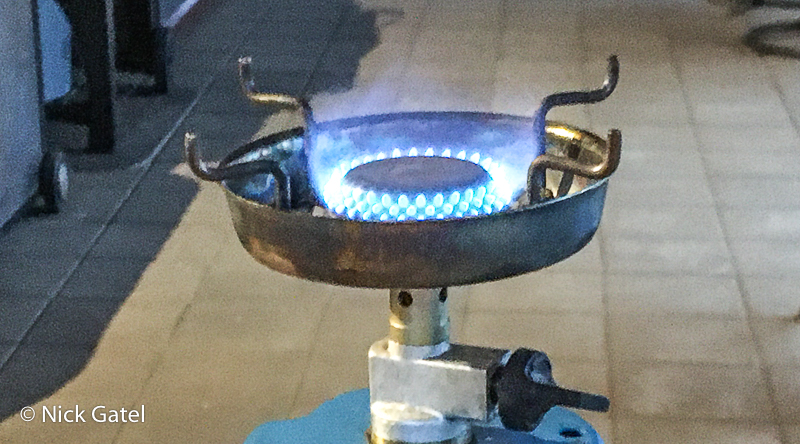
Compact Kit
Today the Globetrotter pot set is highly prized by some owners of the Svea 123 stove. The three pictures below show how it is nested into the Globetrotter pots.
The second pot can be used as a lid or even a mini double boiler
All in all, you can see that this stove, which was released in the ‘70s, had many well thought out design elements. And it just plain worked well.
Camping Gaz Canisters
There was only one canister that fit the stove and only Camping Gaz sold it; the GT106 fuel canister. The canister contained 90 grams of butane. It is almost identical in size to the common IsoPro canisters used today for almost every canister stove on the planet. The small IsoPro canisters hold around 110 grams of a butane/propane gas mixture.
I really don’t remember when I bought the stove, but it was the early ‘80s. Canisters were fairly easy to find at department stores and chain sporting goods stores like Big 5. I do remember driving to LA and buying a couple cases of canisters from GEMCO, when they had a Going Out of Business Sale. This must have been in 1986.
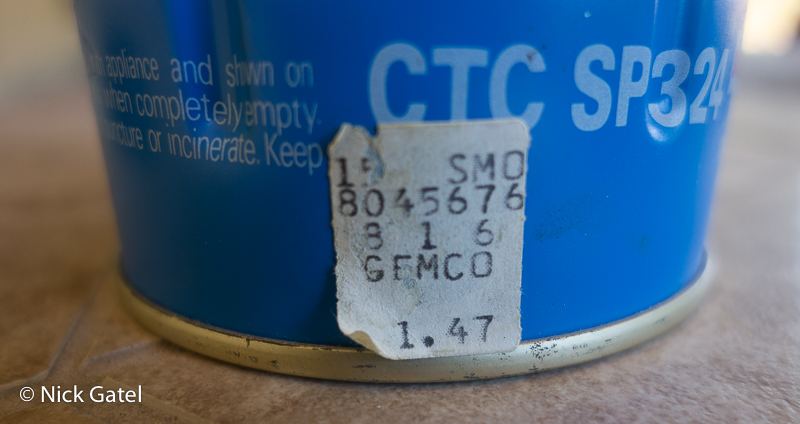 See this blurb from Wikipedia:
See this blurb from Wikipedia:
Gemco was an American chain of membership department stores that was owned by San Leandro-based Lucky Stores, a California supermarket company which eventually became part of Albertsons. Gemco operated from 1959 until closing in late 1986. A number of the west coast stores were sold to Target which fueled their entry into California. Gemco had a version called Memco, also owned by Lucky Stores, that operated stores in the Chicago, Illinois, and Washington, D.C., areas.
Gaz Globetrotter in Action
To attach the canister, the base had to be removed from the upper stove assembly. All the steps can be done without any tool. With the upper section removed, the fuel canister is placed into the base and secured by the two swivel legs.
Once the canister is in the base, the top stove assembly is screwed into the top of the base. First, though, take a look at the puncture needle at the bottom of the upper stove section’s control valve (See below).
As the top is screwed into the base, the needle punctures the canister and the rubber grommet seals the top section against the top of the canister.
The top stove assembly screwed all the way into the base (below).
One thing that cannot be done is remove a partially full canister from the stove, because all the fuel will leak out. But why would you want to do this? The stove can be stored in the pots with the canister attached. Below is a picture of an empty canister. You can see the puncture hole in the top. Also note the top of the canister is indented around the hole. This is not caused by inserting the top stove assembly, but is manufactured into the canister design to ensure a tight seal.
 I still have three or four of these canisters.
I still have three or four of these canisters.
Gaz Globetrotter Stove Upgrade
Since it is such a great little stove, I hate to throw it away because I can no longer buy canisters. So a solution was needed. I decided to see if I could take the valve body from a modern stove, which have a Lindal type fitting. If I could, then I could start using the common IsoPro canisters found today. Years ago, Coleman bought Camping Gaz. A while after the takeover, it was Coleman who discontinued the Globetrotter and the Camping Gaz canisters. Coleman then released canister stoves that use IsoPro canisters. So my thought was, Coleman probably didn’t build these new stoves from scratch. They probably would use some of the older manufacturing tooling and even the same parts or same part designs of Camping Gaz. So I bought an inexpensive Coleman Peak 1 canister stove on Amazon for under $20.
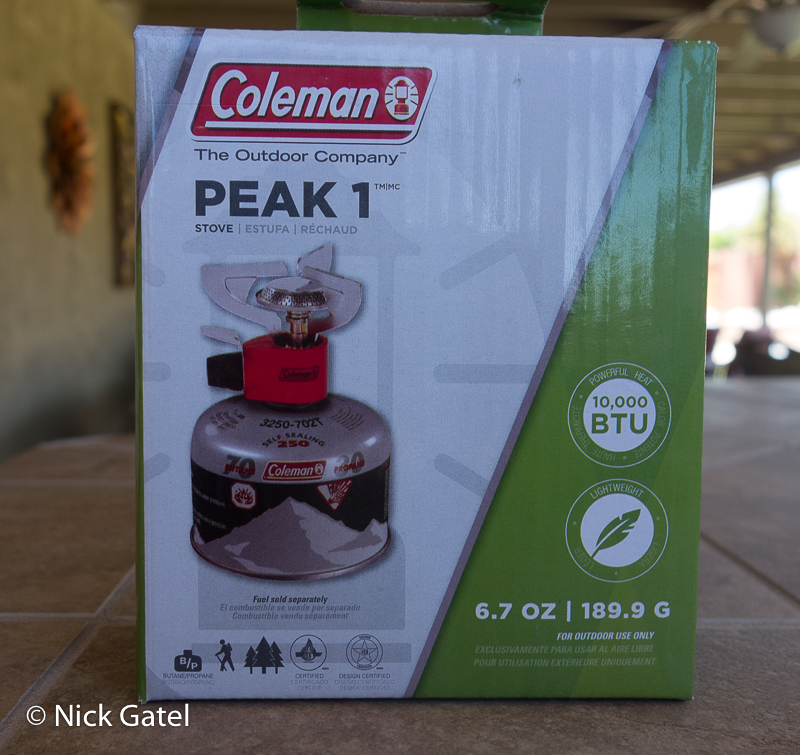
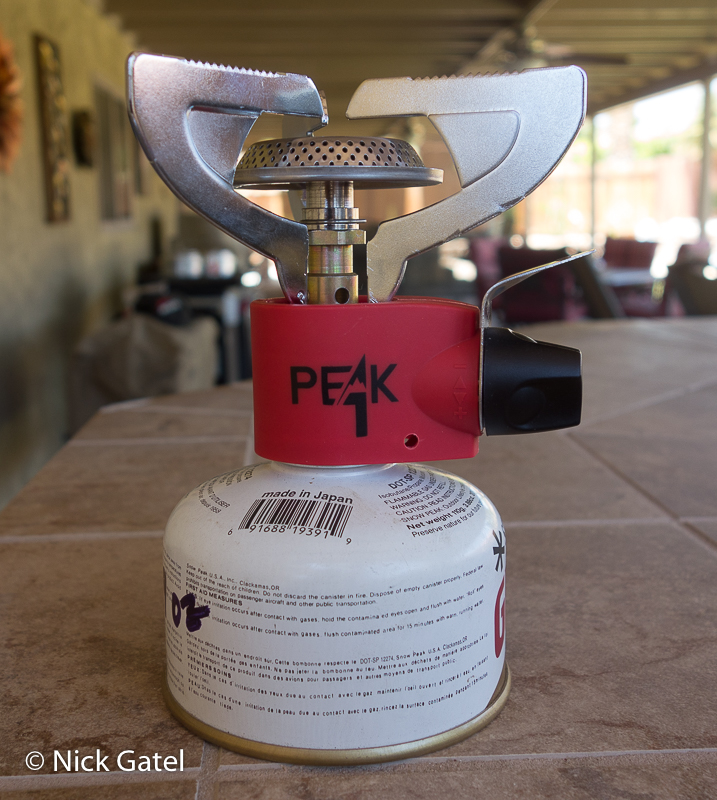
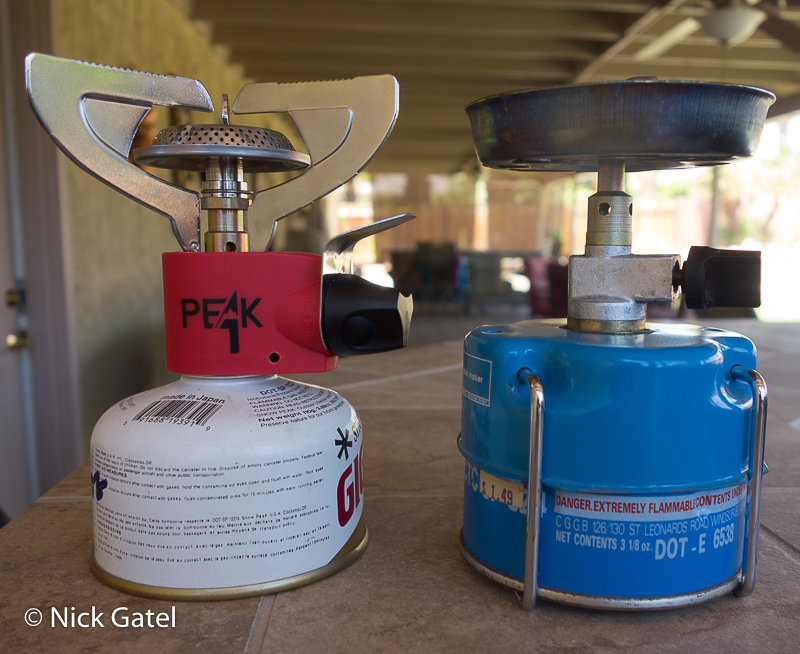

Coleman Peak 1 Disassembly
No tools were needed to disassemble either stove, except for a tiny screw driver to separate the red covering on the bottom of the Coleman Peak 1.

Gaz Globetrotter Disassembly
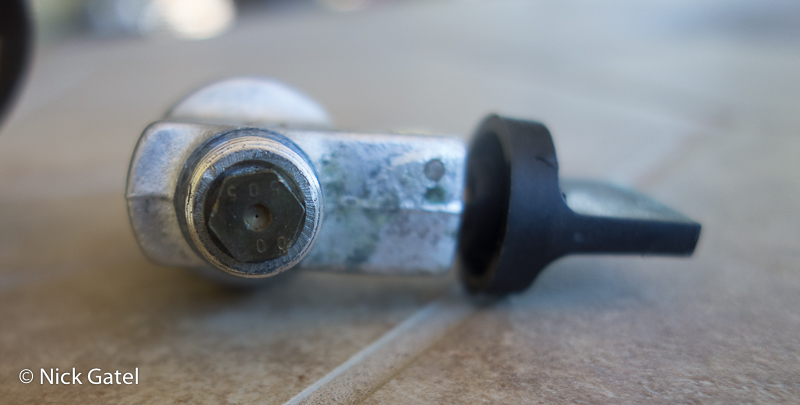
I had a concern that the orifice in the Coleman jet might be larger than the Globetrotter because the Coleman has a larger burner. Also, I didn’t know if the threads of both jets were the same. Lastly, it might be difficult to remove a 35+ year-old jet from the Globetrotter valve body. I could not find any references for propane stove jet sizes. There were two numbers on each jet, probably related to jet/orifice size:
- Globetrotter = 00 & 505
- Coleman = 015 & 556
So I’m pretty sure the Coleman orifice is a little larger. Inspecting both with a magnifying glass showed no discernable difference. So I decided leave the jet in the new Coleman valve body and proceed. I screwed the Globetrotter stove burner onto the new Coleman valve. Thread size and overall design was a perfect match. Then I attached a IsoPro canister because I had a feeling the stove wouldn’t fit into the pot because the new valve knob was larger.
Nope, it wouldn’t fit. My next thought was maybe I could simply pull the knob off of each and switch. Closely inspecting the knob on the new valve, I noticed is was just a thin plastic cap covering the “real” knob. There were three plastic tabs on this cover. Using a small screwdriver I pried the tabs back, which required very, very little pressure. The plastic cap popped off.
Aha! Okay, everything was going to fit. So I assembled everything. Holding my breath I lit the burner. No flare-up. It lit instantly with a small flame. Flame adjustment was easy and perfect. Nice blue flame, indicating a perfect air/fuel mixture. The new and improved stove is on the left, and it shorter than the original, which helps with stability.
 I can now use even larger canisters.
I can now use even larger canisters. 
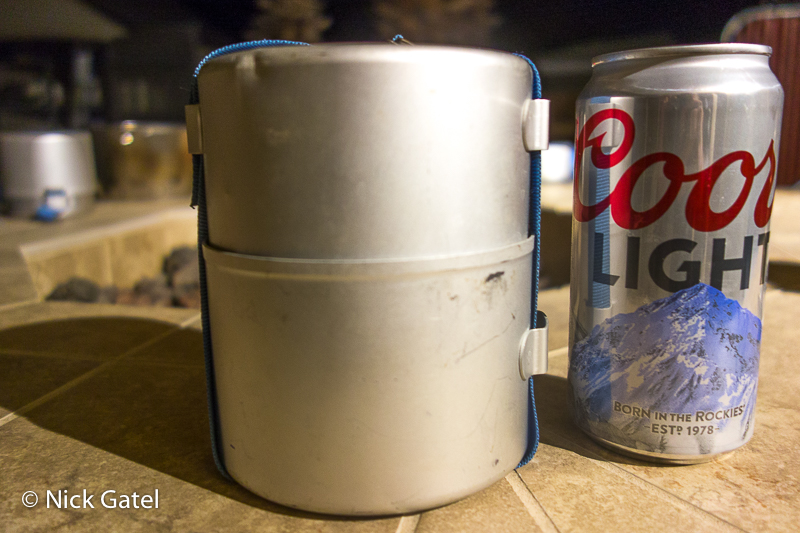
Total weight of pots, stove, handle, and strap is 15.75 ounces.
This website may be compensated for linking to other sites or for sales of products. As an Amazon Associate I earn a small fee from qualifying purchases at no additional cost to the purchaser.

